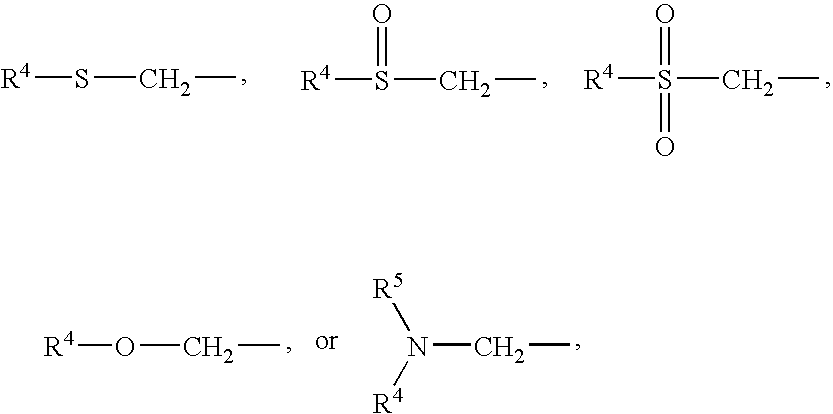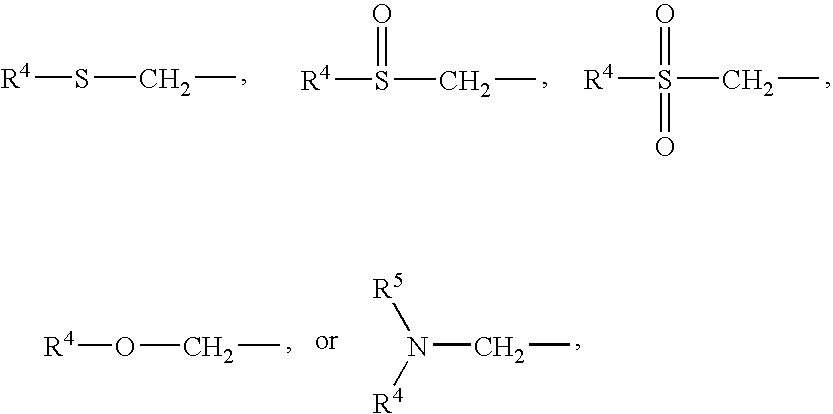Compounds for the treatment of CNS and amyloid associated diseases
a technology for amyloid-associated diseases and compounds, which is applied in the direction of biocide, anti-inflammatory agents, drug compositions, etc., can solve the problems of delivering the therapeutic agent into the brain, and achieve the effects of enhancing clearance, blocking and reducing the risk of cns and amyloid-induced neurotoxicity or microglial activation
- Summary
- Abstract
- Description
- Claims
- Application Information
AI Technical Summary
Benefits of technology
Problems solved by technology
Method used
Image
Examples
example 1
Synthesis of Library of Exemplary Compounds
[0333] Library compounds were synthesized in accordance with the following exemplary schemes:
Synthesis of library (Route 1):
[0334] Step 1 (deprotection): A solution of Fmoc-Gly-Wang resin (5 g, 5 mmol) in a fritted syringe was washed 4 times with DMF (30 mL). To cleave the Fmoc group, 35 mL of a 30 % piperidine / N-methylpyrrolidinone (NMP) solution was added to the resin and the suspension was shaken for 30 minutes. The reagents and solvent were filtered and the resin was washed 4 times with NMP (35 mL). A deep blue color on a Kaiser test was observed, indicating free amine.
[0335] Step 2 (Activation):
[0336] A solution of benzophenone imine (2.54 mL, 15 mmol) and glacial acetic acid (840 μL, 15 mmol) in NMP (35 mL) was prepared and the solution was introduced to the fritted syringe containing the free amino resin (Step 1, ˜5 g, ˜5 mmol). The suspension was shaken overnight at room temperature. The reagents and solvents were then remove...
example 2
Binding of Exemplary Compounds to the Brain L1 Transport System
Dilution of Library Compounds for Use in Competitive Binding Assay
[0366] Compound samples in PBS (without Ca+2, Mg+2)-glucose 30 mM-HEPES 10 mM—DMSO 1% as prepared in Example 1 were thawed and left for at least 30 minutes at 20-23° C. before preparation of the following sub-dilutions for the competitive binding assay: [0367] 200 μL of the stock solution were added to 800 μL PBS (without Ca+2, Mg+2)-Glucose-HEPES-1% DMSO (PBSD-1) [diluted 1:5 for a final 1:5 dilution][0368] 100 μL (1 / 5 dilution above) were added to 900 μL PBSD-1 [diluted 1:10 for a final 1:50 dilution][0369] 100 μL (1 / 50 dilution above) were added to 900 μL PBSD-1 [diluted 1:10 for a final 1:500 dilution]
[0370] These sub-dilutions were used immediately or stored overnight at 4° C. before the competitive binding assay. A volume of 45 μL of each of the compound dilutions (1:5, 1:50, 1:500) in PBSD-1 was added to the appropriate wells in the dilution plat...
example 3
Measurement of Intrinsic Compound Toxicity
Dilution of Library Compounds for Use in Toxicity Study
[0393] Compound samples in PBS (without Ca+2, Mg+2)-glucose 3 mM-HEPES 10 mM—DMSO 1%, as prepared in Example 1, were thawed and left for at least 30 minutes at 20-23° C. before preparation of the following sub-dilutions for the compound toxicity assay: [0394] 100 μL of stock compound solution were added to 900 μL PBSD-1 [diluted 1:10 for a final 1:10 dilution][0395] 100 μL (1 / 10 dilution above) were added to 900 μL PBSD-1 [diluted 1:10 for a final 1:100 dilution]
Culture of HUVEC
[0396] Endothelial cells from human umbilical cord (HUV-EC-C or HUVEC) were purchased form American Type Culture Collection (ATCC, CRL-1730) and cultured according to the manufacturer's protocol. A 1-mL frozen aliquot of sub-cultured cells was thawed in a 37° C. water bath and centrifuged following addition of 5 mL of medium. After re-suspension in 5 mL medium, cells were seeded in a TC80 cm2 flask pre-coated...
PUM
| Property | Measurement | Unit |
|---|---|---|
| concentration | aaaaa | aaaaa |
| pH | aaaaa | aaaaa |
| particle size | aaaaa | aaaaa |
Abstract
Description
Claims
Application Information
 Login to View More
Login to View More - R&D
- Intellectual Property
- Life Sciences
- Materials
- Tech Scout
- Unparalleled Data Quality
- Higher Quality Content
- 60% Fewer Hallucinations
Browse by: Latest US Patents, China's latest patents, Technical Efficacy Thesaurus, Application Domain, Technology Topic, Popular Technical Reports.
© 2025 PatSnap. All rights reserved.Legal|Privacy policy|Modern Slavery Act Transparency Statement|Sitemap|About US| Contact US: help@patsnap.com



